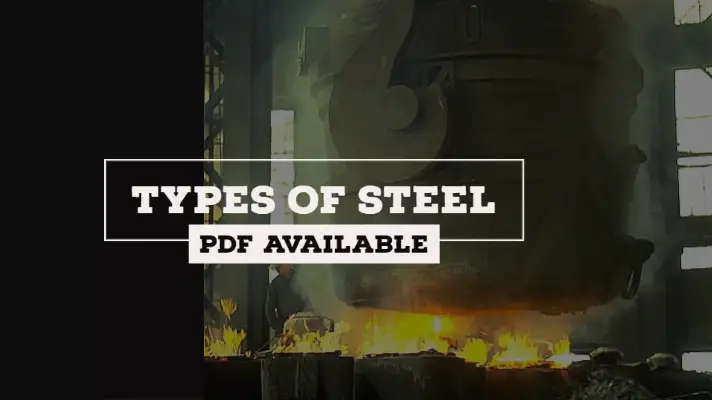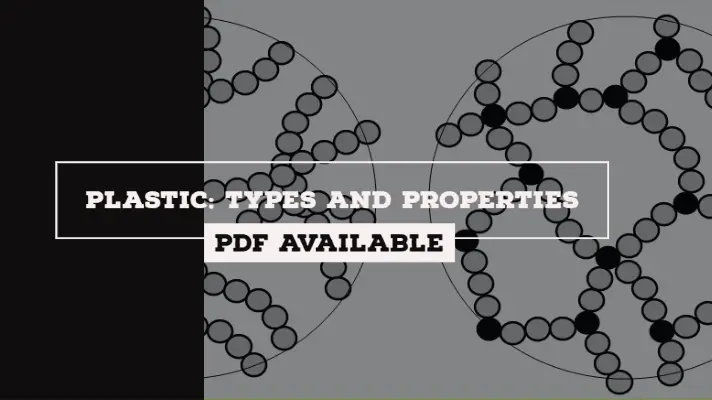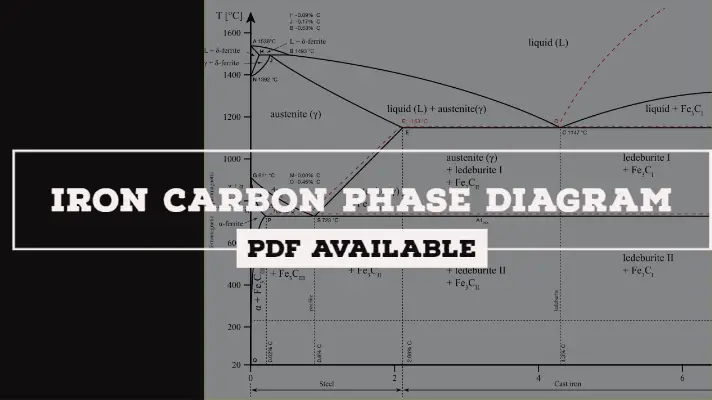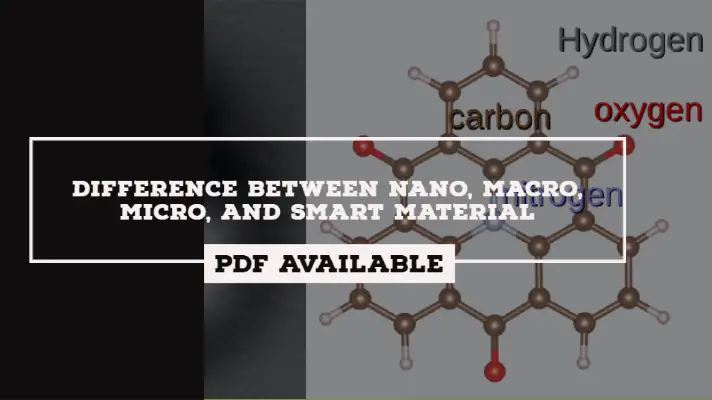Mechanical Properties of Metals [PDF]
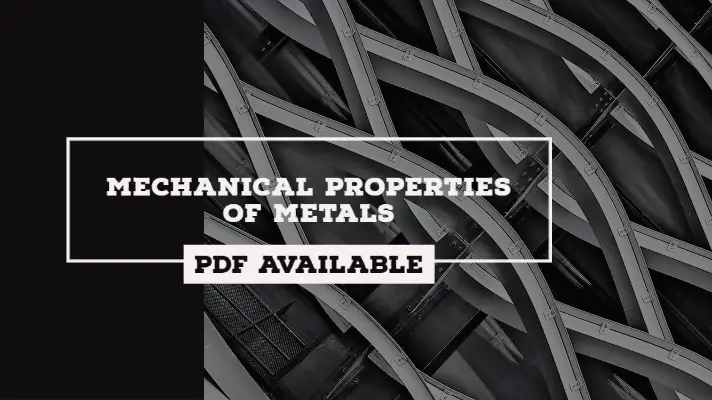
In the last session, we had learned about Different Types of steels and also the Methods for Manufacturing of Steel, and Today we are going to discuss Mechanical Properties of Metals in a detailed way.
If you are a design engineer from the field of Mechanical Engineering then you should have to know about Mechanical properties of metals so that, those can be taken into consideration while designing.
That's the basic consideration every design engineer must follow in picking up on the best material depending upon the Mechanical properties of metals.
Considering this fact, I will be explaining about 33 Mechanical properties of metals that every Mechanical engineer must know. Read this article completely so that it can be used in Interviews also.
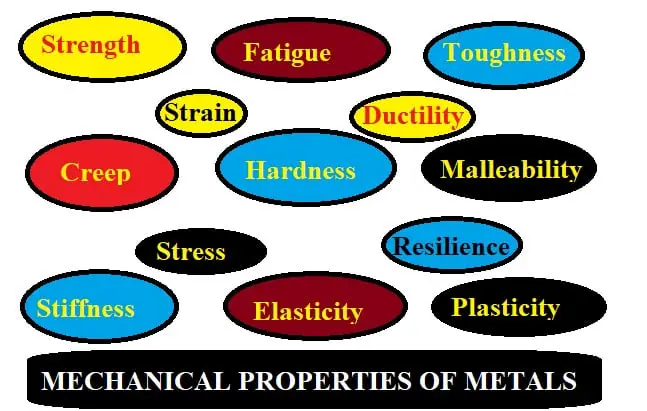
Different Mechanical Properties of Metals:
1. Strength:
The ability of a material that can withstand to Mechanical load is called Strength of that particular material.
- A strength of the material depends upon the directions in which it is loaded
- For example, Tensile Test
- From Tensile Test, we get Tensile Strength, ductility, fracture toughness, resilience, yield stress, etc.
2. Ductility:
The ability of a material that can undergo plastic deformation before failure is called Ductility.
Ductility(D)= % of Elongation in length or % of Reduction in Cross-section at breaking point.
Note: Ductility is always reported in % of elongation in length but not in % of the reduction in c/s area because a reduction in c/s section area is small and difficult to measure during testing.
% of the elongation at different Temperatures:
If you can see the % of elongation of a metal w.r.t.Low temperature(L.T),Room temperature(R.T) and High temperature(H.T) was
D(L.T)<D(R.T)<D(H.T)
3. Fracture Toughness:
The ability of a material that can absorb energy at the time of failure against fracture is called Fracture Toughness.
- By calculating the area under stress v/s strain curve up to the failure point, the fracture toughness of the material is determined.
- A material possesses high fracture toughness means it has a higher capacity to absorb more strain energy against failure.
- A brittle material possesses lower the fracture toughness(F.T) compared to a ductile material because of the area under the curve.
A Ductile > A Brittle
F.T Ductile > F.T Brittle
Considering an area of Stress v/s Strain curve at different temperatures is noted as follows.
A H.T > A R.T > A L.T
That implies
F.T H.T > F.TR.T > F.T L.T
If the material is tested at high temperature, the displacement of atomic planes is easy, implies it can produce more plastic strain, implies area under the curve will be more, implies Fracture Toughness is high.
4. Hardness:
The resistance offered by the material against mechanical deformation is called hardness.
5. Brittleness:
The ability of a material that can withstand mechanical load without plastic deformation is called Brittleness.
6. Stiffness:
The ability of a material that can resist mechanical deformation under stress is called stiffness.
7. Creep:
Time v/s Strain behavior of a material under Constant mechanical load is called Creep.
8. Fatigue:
Stress v/s no. of load cycles of the behavior of metal under changing mechanical load with Time is called as Fatigue.
- Fatigue is a danger than Creep
- Therefore, more FOS is given for Fatigue loading.
9. Malleability:
It is a capability of being extended or shaped by beating with a hammer or by the external pressure of rollers so that the output is in the form of thin sheets called as Malleability.
10. Plasticity:
The quality of being easily shaped or molded called Plasticity.
11. Elasticity:
The ability of an object or material to resume or regain its normal shape or original shape after being stretched or compressed called Elasticity.
12. Toughness:
It is the state of being strong enough in order to withstand adverse conditions or rough handling called Toughness. or It is also defined as the Area under P.(Delta) curve up to Failure is called as Toughness.
13. Tensile strength:
The resistance of a material to breaking under tension called Tensile Strength.
14. Compressive strength:
The resistance of a material to breaking under Compression is called Compressive strength.
15. Resilience:
The ability of a material that can absorb energy without undergoing any shape change called Resilience.
For example, Steel
By calculating the area under Stress v/s Strain curve up to an elastic point, resilience (elastic resilience) of the material will be determined.
16. Hardenability:
The hardenability of a metal alloy is the depth up to which a material is hardened after putting through a heat treatment process called hardenability.
17. Machinability:
It is a process of removing the layer from the surface of the workpiece so as to get a good surface finish on the outer surface of the material called Machinability.
In the most general case, good machinability means that material is cut with good surface finish, long tool life, low force, power requirements, and low cost.
18. Stress:
When a material is loaded with a force, it produces stress which then causes the material to deform. or Stress is defined as "force per unit area" - the ratio of applied force F to the cross-section area is called stress.
19. Youngs Modulus:
Young's modulus is the ability of a material to withstand changes in length when under lengthwise tension or compression.
- It is denoted by E.
- It is also defined as the ratio of stress to strain.
20. Elastic deformation:
It is a change in the shape of a material at low stress that is recoverable after the stress is removed called as Elastic deformation of a material. Or a temporary shape change that is self-reversing after the force is removed, so that the object returns to its original shape called as the elastic deformation
21. Plastic deformation:
Plastic deformation is a process in which permanent deformation is caused by a sufficient load. It produces a permanent change in the shape or size of a solid body without fracture, resulting from the application of sustained stress beyond the elastic limit.
After plastic deformation, no elastic recovery takes place.
22. The factor of safety:
It is the load-carrying capacity of a system beyond the expected or actual loads. Or the factor of safety is how much stronger the system is that it usually needs to be for an intended load.
The factor of safety is different for brittle and ductile materials.
23. Elastic Recovery:
It is the measure of the ability of an elastomer to return to its original shape when a compression load or external load is removed called Elastic Recovery.
24. Engineering stress:
Engineering stress is the applied load divided by the original cross-sectional area of a material. It is also called nominal stress.
25. True stress:
True stress is the applied load divided by the actual cross-sectional area (the changing area with respect to time) of the specimen at that load.
26. Poissons Ratio:
Poisson's ratio is the ratio of transverse contraction strain or Lateral strain to the longitudinal extension strain(Linear strain).
27. Bulk Modulus:
It is the relative change in the volume of a body produced by a unit tensile or compressive stress acting uniformly over its surface.
28. Rigidity Modulus:
It is also known as shear modulus
It is defined as the ratio of shear stress to the shear strain.
29. Bond:
It possesses a metallic bond.
30. Binding Energy:
The distance between the atoms is less and thereby the Binding energy is high.
31. Conductivity:
The metals possess good electrical conductivity because of the presence of free electrons.
32. Thermal Conductivity:
The metals possess good thermal conductivity.
33. Density:
The metals possess high density which means that the weight of the metal is more and this is one of the disadvantages of metals.
34. Corrosiveness:
The metals are highly corrosive to the environment.
35. Recyclability:
The metals are partially recyclable in nature.
36. Strain:
It is defined as the ratio of change in dimension to its original dimensions called a strain.
- It is denoted by "Ɛ"
- It is a Dimensionless parameter
- Strains the response of a system to applied stress.
Strain is divided into 3 major categories, those are:
- Normal Strain
- Shear Strain
- Volumetric Strain
1. Normal Strain:
- It is defined as the ratio of change in dimension to its original dimension.
- It is due to the normal forces and it is represented by e or ε.
- It is a dimensionless parameter.
If we consider the dimension as Length then Change in length to its original length is the Normal strain and it is represented below.
Let “L” be the Length of the component and “dL” will be the Change in Length of the component then the representation of the Normal strain is
e or ε = dL/L
2. Shear Strain:
- It is defined as the angular distortion between any two mutually perpendicular planes in radian's is the shear strain.
- It is due to shear force or tangential force acting on a specimen.
- It is represented by gamma (γ).
Representation:
Consider a component which is subjected to equal and opposite forces on either face (AB&CD) and one end of the face(AB) is fixed and the other end(DC) is kept free. Due to the application of force on one of the face, the component gets distorted through an angle of φ to the shape ABC’D’.
Now Shear strain or deformation per unit length is of the component is = CC’ / CD = CC’ / BC = * radian
3. Volumetric strain:
- It is defined as the ratio of change in volume to its original volume.
- It is due to the normal forces only.
- It is a dimensionless parameter.
Representation
This means that the volumetric strain of a deformed body is the sum of the linear strains in three mutually perpendicular directions.
- Due to normal forces, there will be dimensional and volumetric changes.
- Due to shear, there will be distortion in shape without a change in volume.
- Stress depends on strain.strain is an independent parameter and stress depends on the strain.
Some Other Mechanical Properties are:
In order to use any material for the engineering practice, you should have to know all the features related to it.which means we should have to know whether the component has a homogeneous property, Isotropic property, Orthotropic property or An-isotropic property.
So in order to know all these things, I had written an article about the difference between them and was presented below.
Homogeneous Property:
At any point in One Direction, if the properties of the material were the same called Homogeneous Property.
For example, Wood, Iron, Silver, Copper, Gold, etc.
Isotropic property:
At one point, in any direction, if the properties of the material are the same called isotropic property.
For example, very fine grained molecules,iron, copper,silver,brass etc.
- As the name of isotropic itself says that Iso is same and Tropic is directional property.
- All homogeneous materials need not be isotropic and vice versa however some homogeneous materials are isotropic also.
Orthotropic Property:
At one point in mutually perpendicular directions, if the properties of the material are different, then it is called as Orthotropic Property.
- It is a perpendicular directional property.
For example, Layered materials,wood,asbestos, graphite,mica,onion etc.
An-isotropic Property:
- At one point, in any directions, if the properties of the material are different called as an Anisotropic property.
- It is also called as Alletropic property.
For example, Material with small cracks and voids, cracked glass, cracked metal, etc.
So this is a complete explanation of Mechanical Properties of Metals, I hope you liked it, please feel free to share your thoughts and doubts in the comment section, I will love to answer those.
More Resources:
Non-Ferrous Metals
Basic Fluid Mechanics Q & A
References [External Links]:
- Mechanical Properties of Materials-PDF
- The Physical and Mechanical Properties of Metals and Alloys




